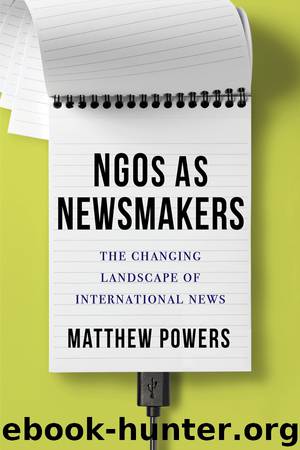NGOs as Newsmakers by Matthew Powers

Author:Matthew Powers
Language: eng
Format: epub
Publisher: Columbia University Press
INCENTIVIZING MEDIA-CENTRISM
As we have already seen in the preceding chapters, NGO professionals care a great deal about mainstream media coverage. Different organizations value different types of coverage for different reasons (e.g., some prefer coverage in the elite press as a way to influence policy debates, whereas others target television news media to raise public awareness or boost funds). Moreover, there are tensions between most advocacy groups and the news media (e.g., over negative publicity or poor understanding of a particular human rights issues). Finally, the publicity strategies of all advocacy organizations are marked by a reflexive and strategic character, wherein advocates seek to make the best of sometimes seemingly unfavorable publicity conditions. Yet the enduring desire for positive publicity in the legacy news media was a constant theme across all interviews. To many interviewees, coverage in the news media remains the leading aim of publicity efforts. As a media officer at Oxfam put it, “A page 5 in the New York Times will always be a page 5 in the New York Times. Nothing is ever going to change that.”6
As many interviewees were quick to point out, the ongoing interest in cultivating mainstream media coverage does not mean that digital tools are shunned. In fact, most respondents discussed the possibilities (as well as the emergent drawbacks) of using digital tools to explore new forms of publicity. Nearly all organizations studied have built up their digital-media staff, and these individuals help to conduct publicity campaigns that make innovative use of online tools (e.g., websites, social media feeds, and so on) to raise awareness of issues not covered by the news media. Interestingly, though, many of the examples of successful digital-media use were campaigns that ultimately made their way into the mainstream news media. Thus, as we have already seen, digital-media tools are being used mostly to interact with—rather than to directly bypass—the mainstream media in potentially new ways.
When asked why their organizations continue to emphasize coverage in the mainstream news media, interviewees described three factors that incentivize their publicity strategies. The first two—donor demands and government officials’ media-consumption habits—have little to do with what new institutional theorists describe as path dependencies (e.g., start-up costs, feedback effects, knowledge accumulation). These two factors instead detail ways in which path dependence in the fields of philanthropy and politics incentivize NGOs to continue in their “media-centric” publicity strategies. These reinforcing path dependencies are sustained via the more standard forms of path dependence. In particular, respondents described a social proximity between NGOs and journalists that have led the former to see the latter as a potential ally in the struggle for publicity.
Download
This site does not store any files on its server. We only index and link to content provided by other sites. Please contact the content providers to delete copyright contents if any and email us, we'll remove relevant links or contents immediately.
| Anthropology | Archaeology |
| Philosophy | Politics & Government |
| Social Sciences | Sociology |
| Women's Studies |
The Secret History by Donna Tartt(18158)
The Social Justice Warrior Handbook by Lisa De Pasquale(11951)
Thirteen Reasons Why by Jay Asher(8451)
This Is How You Lose Her by Junot Diaz(6435)
Weapons of Math Destruction by Cathy O'Neil(5829)
Zero to One by Peter Thiel(5488)
Beartown by Fredrik Backman(5353)
The Myth of the Strong Leader by Archie Brown(5237)
The Fire Next Time by James Baldwin(5016)
How Democracies Die by Steven Levitsky & Daniel Ziblatt(4954)
Promise Me, Dad by Joe Biden(4908)
Stone's Rules by Roger Stone(4857)
100 Deadly Skills by Clint Emerson(4690)
A Higher Loyalty: Truth, Lies, and Leadership by James Comey(4550)
Rise and Kill First by Ronen Bergman(4545)
Secrecy World by Jake Bernstein(4388)
The David Icke Guide to the Global Conspiracy (and how to end it) by David Icke(4379)
The Farm by Tom Rob Smith(4323)
The Doomsday Machine by Daniel Ellsberg(4245)
